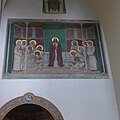Carl Johann Becker-Gundahl
Carl Johann Becker-Gundahl (born April 4, 1856 in Ballweiler (now part of Blieskastel / Saarland ), † November 16, 1925 in Solln (now part of Munich)) was a German church painter and draftsman of Art Nouveau and Impressionism as well as a university professor at the Academy of Fine Arts Munich and member of the Munich Secession .
Live and act
Carl Johann (often also: Karl-Johann) Becker-Gundahl attended a drawing school in Mannheim after an apprenticeship as a carpenter and from 1873 worked for a sculptor in Munich . In 1875 Becker-Gundahl entered the Munich Academy and became a student of Wilhelm von Diez and Ludwig von Löfftz . After some short-term employment, such as as a drawing teacher in Kiel , he returned to Munich in 1882 and studied in the class of Gabriel von Max . He developed a monumental style that made him one of the most successful independent Munich wall painters of his time. He was awarded the Grand State Prize in Berlin for his painting The Auschgler at the End (1884) . In 1892 Becker, who had added the name Gundahl after his grandmother, was one of the founders of the Munich Secession and contributed drawings to the journals Die Jugend and Fliegende Blätter . From 1900 he received larger orders for frescoes and mosaics in churches such as Sankt Maximilian in Munich's Isarvorstadt (former Marien Altar, mosaic on the front wall of the aisle "Verherrigung Mariae", Maximilian statue in apse) and Sankt Johann Baptist in Munich-Solln (high altar picture "Die Baptism of Jesus by John on the Jordan ") or for the fresco of the war memorial chapel in Jockgrim .
His most important ecclesiastical works are the frescoes of the Wedding at Cana and Communion of the Apostles, created in 1907/08 in the transept of St. Anne's Church in Munich. His war crucifixion was made in 1914 , which is now in the Pfalzgalerie in Kaiserslautern and, like his picture Praying Peasant Women, is evidence of the Christian reference of his works.
In 1906 he was appointed professor for drawing and monumental painting at the Munich Academy of the Arts, where he taught until 1924. His students included Franz Doll , Heinrich König , Hermann Kaspar , Christian Schad , Alois Bergmann-Franken , Paula Wimmer , Peter von Ostrowski , Josef Hendel , Oskar Martin-Amorbach , Fritz Harnest , Richard Huber , Franz Zettler , Margarethe Raabe , Christian Hess , Hans Egger , Paul Hermann Schoedder , Karl Böhmer, Max Eschle , Wilhelm Breyvogel, Rudolf Schmalfuß and many others.
Becker-Gundahl died in Solln in 1925, and streets and a school are named after him there and in his home town of Ballweiler. His grave is at the Solln forest cemetery (41-3-30). He left behind numerous works, such as oil paintings, studies, drawings and designs for church frescoes, which still often appear at auctions today.
literature
- Albert Becker: Becker, Carl Johann. In: New German Biography (NDB). Volume 1, Duncker & Humblot, Berlin 1953, ISBN 3-428-00182-6 , p. 712 f. ( Digitized version ).
- Wilhelm Weber : Carl Johann Becker-Gundahl. In memory of the Saar-Palatinate painter. Museum of the City of Homburg / Saar, 1957
- Wilhelm Weber: In memory of Carl Johann Becker Gundahl . In: Saarheimat 1960, Heft 3, 1960, pp. 2-10
- Carl Johann Becker-Gundahl (1856-1925). Catalog for the exhibition in the Orangery Blieskastel, November 25, 1990 to January 2, 1991 . Blieskastel 1990
Web links
- Literature by and about Carl Johann Becker-Gundahl in the catalog of the German National Library
- Biography, Saarpfalz district
- Saarland biographies
- Detailed biography, Solln
- Matriculation entry Adbkm with photo 1907 and complete list of students
- Carl Johann Becker-Gundahl in HeidICON illustrations of the flying leaves
| personal data | |
|---|---|
| SURNAME | Becker-Gundahl, Carl Johann |
| ALTERNATIVE NAMES | Becker-Gundahl, Karl-Johann |
| BRIEF DESCRIPTION | German painter and university professor |
| DATE OF BIRTH | April 4, 1856 |
| PLACE OF BIRTH | Ballweiler |
| DATE OF DEATH | November 16, 1925 |
| Place of death | Munich |


